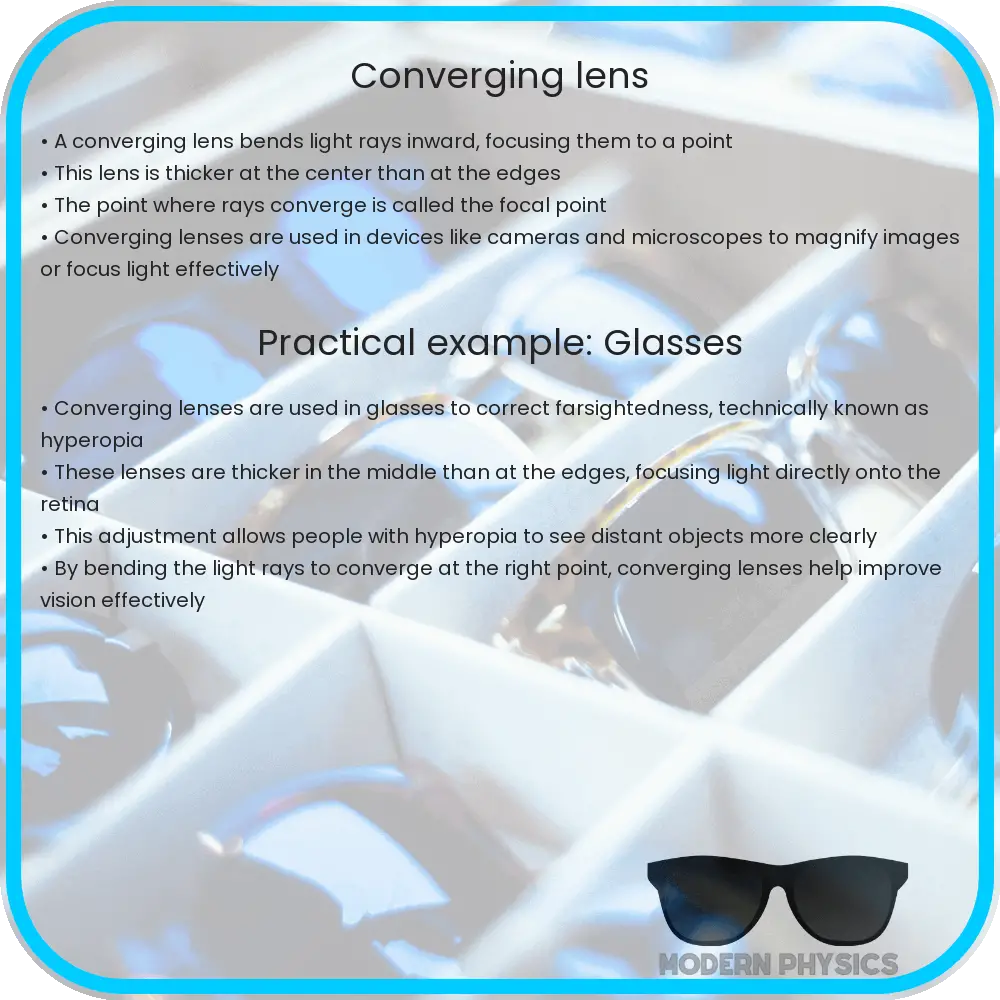Explore the principles, uses, and applications of converging lenses in technology, from correcting vision to advancing scientific research.

Understanding Converging Lenses: Principles and Uses
A converging lens, also known as a convex lens, plays a pivotal role in various optical devices due to its ability to bend light rays toward a focal point. This fundamental principle stems from the lens’s shape, thicker at the center than at the edges, allowing it to converge light rays from a source to a single point. When light rays enter the lens parallel to its axis, they refract towards the lens’s focal point, located on the opposite side. This behavior is governed by Snell’s law of refraction, which describes the relationship between the angle of incidence and the angle of refraction.
Key Applications of Converging Lenses
Converging lenses are ubiquitous in both everyday life and advanced scientific research. One of the most common applications is in eyeglasses for correcting farsightedness. Here, the lens compensates for the eye’s inability to focus light directly on the retina, ensuring clear vision. Additionally, these lenses are integral to the functioning of cameras, where they focus light onto the film or digital sensor to capture sharp images.
- Optical Instruments: Microscopes and telescopes leverage converging lenses to magnify distant or tiny objects. In microscopes, these lenses magnify the object placed near the focal point, producing a larger image. Conversely, telescopes use them to gather and focus light from distant celestial bodies, allowing detailed observation.
- Projectors: In projectors, converging lenses are used to focus and project light from a small image onto a larger screen, enabling audiences to view the image clearly from a distance.
The versatility of converging lenses extends beyond these examples, with applications ranging from simple magnifying glasses to complex optical systems in scientific instruments. Their ability to manipulate light makes them indispensable in fields such as photography, astronomy, and even in the medical sector for devices like endoscopes and ophthalmoscopes.
Conclusion
In conclusion, the principle of light convergence through convex lenses forms the basis of numerous optical devices and applications. From aiding vision to exploring the universe, the role of converging lenses in technology and science is profoundly impactful. Understanding these lenses’ principles and uses not only illuminates the physics behind optical phenomena but also highlights their significance in our daily lives and various professional fields.
Advanced Applications and Technological Innovations
The scope of converging lenses extends into cutting-edge technologies and scientific research. In the realm of laser technology, converging lenses are essential for focusing laser beams in applications ranging from laser cutting and welding to medical surgeries. These lenses ensure precision and control by concentrating laser light into a fine point, allowing for meticulous work on materials and tissues.
In the field of photography, especially in high-end cameras, converging lenses are part of complex lens systems designed to correct aberrations and enhance image quality. These lenses work together to minimize distortions and focus light accurately across different wavelengths, producing clear and vibrant images.
- Augmented Reality (AR) and Virtual Reality (VR): AR and VR technologies utilize converging lenses to create immersive experiences. These lenses help project digital images into the user’s field of vision, making the digital content appear as if it exists in the real world.
- Optical Communications: In the field of optical communications, converging lenses play a crucial role in focusing light through fiber optic cables. This application is pivotal for transmitting data over long distances with minimal loss, underpinning the backbone of global telecommunications networks.
Moreover, the principles of converging lenses are being explored in emerging fields such as photovoltaics, where lenses are used to concentrate sunlight onto small, high-efficiency solar cells. This approach significantly increases the power output from solar panels, demonstrating the potential of converging lenses in sustainable energy solutions.
Conclusion
The exploration of converging lenses reveals a profound impact on both our daily lives and the advancement of technology. From simple magnifying glasses to sophisticated devices in scientific research, these lenses are fundamental to a myriad of applications. Their ability to focus and manipulate light not only serves practical purposes in vision correction, photography, and optical instruments but also drives innovation in fields like laser technology, AR/VR, optical communications, and renewable energy. As technology evolves, the applications of converging lenses are likely to expand, continuing to illuminate new paths in science and engineering. Understanding the principles and uses of these lenses not only enriches our knowledge of optical science but also inspires appreciation for the intricate ways in which they enhance and enable a wide range of technological achievements.
